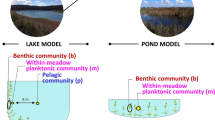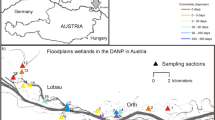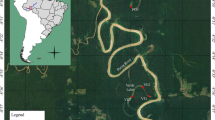Abstract
Understanding models of networks formation is fundamental to explore the role of the structure in the functioning of the systems they describe, and their ability to respond to change. In this work, we aimed to understand whether and how the modular (or compartmented) structure of a network composed by macroinvertebrates and leaf detritus in six pools of aquatic system was related with the decomposition process. First, we evaluated the relationship between the temporal patterns of leaf detritus colonization and the modular subdivision of the network. Modularity was then related with the clustering of the pools based on convergent traits of leaf detritus consumption and environmental conditions. A significant relationship between the colonization patterns and the distribution of taxa and pools in well-defined modules was found. The modular and clustering subdivision of the pools showed a significant overlap, which revealed the intimate linkage between the structure and functioning of the system. Modularity shapes the functional architecture of the network, by increasing the spatial differences of leaf litter decomposition over time and the diversity of functional traits among detritus feeder. As a consequence, modularity influences the variability of communities’ responses to disturbance, increasing the diversity and robustness of functional processes. Our results have also implications from a conservation point of view, showing the importance of habitat heterogeneity for the robustness of ecosystem functioning, potentially enhancing biodiversity with positive, long-term effect on the whole food web.



Similar content being viewed by others
References
Artzy-Randrup Y, Stone L (2005) Generating uniformly distributed random networks. Phys Rev E 72:56708
Barber MJ (2007) Modularity and community detection in bipartite networks. Phys Rev E 76:066102
Barber MJ, Streit L, Strogan O (2011) NetzCope: a tool for displaying and analyzing complex networks. In: Accardi L, Freudenberg W, Ohya M (eds) Quantum bio-informatics IV. World Scientific Publishing, Singapore, pp 437–450
Bastolla U, Fortuna MA, Pascual-Garciá A, Ferrera A, Luque B, Bascompte J (2009) The architecture of mutualistic networks minimizes competition and increases biodiversity. Nature 458:1018–1020
Bellisario B, Cerfolli F, Nascetti G (2010) Spatial network structure and robustness of detritus-based communities in a patchy environment. Ecol Res 25:813–821
Bellisario B, Cerfolli F, Nascetti G (2011) Patterns of species occurrence in detritus-based communities with variable connectivity. Web Ecol 11:1–9
Brouat C, Chevallier H, Meusnier S, Noblecourt T, Rasplus J-Y (2004) Specialization and habitat: spatial and environmental effects on abundance and genetic diversity of forest generalist and specialist Carabus species. Mol Ecol 13:1815–1826
Cebrian J (1999) Patterns in the fate of production in plant communities. Am Nat 154:449–468
Clavel J, Julliard R, Devictor V (2011) Worldwide decline of specialist species: toward a global functional homogenization? Front Ecol Environ 9:222–228
Corse E, Costedoat C, Chappaz R, Pech N, Martin JF, Gilles A (2010) A PCR-based method for diet analysis in freshwater organisms using 18SrDNA barcoding on faeces. Mol Ecol Resour 10:96–108
Cummins KW, Klug MJ (1979) Feeding ecology of stream invertebrates. Annu Rev Ecol Evol S 10:147–172
Devictor V et al (2010) Defining and measuring ecological specialization. J Appl Ecol 47:15–25
Diamond JM (1975) Assembly of species communities. In: Cody ML, Diamond JM (eds) Ecology and evolution of communities. Harvard Press, Cambridge, pp 342–444
Ellwood MDF, Manica A, Foster WA (2009) Stochastic and deterministic processes jointly structure tropical arthropod communities. Ecol Lett 12:277–284
Fortuna MA, Popa-Lisseanu AG, Ibañez C, Bascompte J (2009) The roosting spatial network of a bird-predator bat. Ecology 90:934–944
Gessner MO et al (2010) Diversity meets decomposition. Trends Ecol Evol 25:372–380
Gómez M, Perfectii F, Jordano P (2011) The functional consequences of mutualistic network architecture. PLoS ONE 6:e16143
Grinnell J (1917) The niche-relationships of the California thrasher. Auk 34:427–433
Guimerà R, Amaral LAN (2005) Functional cartography of complex metabolic networks. Nature 433:895–900
Guimerà R, Stouffer DB, Sales-Pardo M, Leicht EA, Newman MEJ, Amaral LAN (2010) Origin of compartmentalization in food webs. Ecology 91:2941–2951
Hooper DU et al (2005) Effects of biodiversity on ecosystem functioning: a consensus of current knowledge. Ecol Monogr 75:3–35
Hubbel SP (2001) The unified neutral theory of biodiversity and biogeography. Princeton University Press, Princeton
Jurado-Rivera JA, Vogler AP, Reid CAM, Petitpierre E, Gómez-Zurita J (2009) DNA barcoding insect-host plant associations. Proc R Soc B Biol Sci 276:639–648
Krause AE, Frank KA, Mason DM, Ulanowicz RE, Taylor WW (2003) Compartments revealed in food-web structure. Nature 426:282–285
Lecerf A, Dobson M, Dang CK, Chauvet E (2005) Riparian plant species loss alters trophic dynamics in detritus based stream ecosystems. Oecologia 146:432–442
Lepoint G, Cox A-S, Dauby P, Poulicek M, Gobert S (2006) Food sources of two detritivore amphipods associated with the seagrass Posidonia oceanica leaf litter. Mar Biol Res 2:355–365
Lewinsohn TM, Prado PI, Jordano P, Bascompte J, Olesen JM (2006) Structure in plant-animal interaction assemblages. Oikos 113:174–184
MacArthur RH (1972) Geographical ecology. Harper & Row, New York
McQueen DJ, Post JR, Mills EL (1986) Trophic relationships in freshwater pelagic ecosystems. Can J Fish Aquat Sci 43:1571–1581
Mello MA, Marquitti FM, Guimãres PR Jr, Kalko EK, Jordano P, de Aguilar MA (2011) The modularity of seed dispersal: differences in structure and robustness between bat- and bird-fruit networks. Oecologia 167:131–140
Moore JC et al (2004) Detritus, trophic dynamics and biodiversity. Ecol Lett 7:584–600
Mouillot D, Villéger S, Scherer-Lorenzen M, Mason NWH (2011) Functional structure of biological communities predicts ecosystem multifunctionality. PLoS ONE 6:e17476
Newman MEJ, Girvan M (2004) Finding and evaluating community structure in networks. Phys Rev E 69:26113
Olden JD (2006) Biotic homogenization: a new research agenda for conservation biogeography. J Biogeogr 33:2027–2039
Olesen JM, Bascompte J, Dupont JL, Jordano P (2007) The modularity of pollination networks. Proc Natl Acad Sci USA 104:19891–19896
Olesen JM, Bascompte J, Elberling H, Jordano P (2008) Temporal dynamics in a pollination network. Ecology 89:1573–1582
Olesen JM, Bascompte J, Dupont YL, Elberling H, Rasmussen C, Jordano P (2011) Missing and forbidden links in mutualistic networks. Proc R Soc B 278:725–732
Olson JS (1963) Energy storage and the balance of producers and decomposers in ecological systems. Ecology 44:322–331
Palmer TM (2003) Spatial habitat heterogeneity influences competition and coexistence in an African acacia ant guild. Ecology 84:2843–2855
Pimm SL, Lawton JH (1980) Are food webs divided into compartments? J Anim Ecol 49:879–898
Proulx SR, Promislow DEL, Phillips PC (2005) Network thinking in ecology and evolution. Trends Ecol Evol 20:345–353
R Development Core Team (2011) R: a language and environment for statistical computing. R Foundation for Statistical Computing, Vienna, Austria. ISBN 3-900051 07-0, URL http://www.R-project.org/
Scherer-Lorenzen M (2008) Functional diversity affects decomposition processes in experimental grasslands. Funct Ecol 22:547–555
Sol D, Timmermans S, Lefebvre L (2002) Behavioural flexibility and invasion success in birds. Anim Behav 63:495–502
Stouffer DB, Bascompte J (2011) Compartmentalization increases food-web persistence. Proc Natl Acad Sci USA 108:3648–3652
Strong DR (1982) Harmonious coexistence of hispine beetles on Heliconia in experimental and natural communities. Ecology 63:1039–1049
Ulrich W (2004) Species co-occurrences and neutral models: reassessing J. M Diamond’s assembly rules. Oikos 107:603–609
Valentini A, Pompanon F, Taberlet P (2009) DNA barcoding for ecologists. Trends Ecol Evol 24:110–117
Vázquez DP, Melián CJ, Williams NM, Blüthgen N, Krasnov B, Poulin R (2007) Species abundance and asymmetric interaction strength in ecological networks. Oikos 116:1120–1127
Wardle DA, Yeates GW (1993) The dual importance of competition and predation as regulatory forces in terrestrial ecosystems: evidence from decomposer food webs. Oecologia 93:303–306
Weiher E, Keddy P (1999) Assembly rules as general constraints on community composition. Cambridge University Press, Cambridge
Williams RJ (2011) Biology, methodology or chance? The degree distributions of bipartite ecological networks. PLoS ONE 6:e17645
Yee DA, Yee SH, Kneitel JM, Juliano SA (2007) Richness–productivity relationships between trophic levels in a detritus-based system: significance of abundance and trophic linkage. Oecologia 154:377–385
Acknowledgments
We wish to thank the State Forestry Department for access to the sampling sites within the Natural Reserve of Tarquinia Saltern. We are also in debt with the handling editor and two anonymous referees, whose constructive comments and suggestions greatly improved the manuscript.
Author information
Authors and Affiliations
Corresponding author
Additional information
Handling Editor: Piet Spaak
Rights and permissions
About this article
Cite this article
Bellisario, B., Cerfolli, F. & Nascetti, G. The interplay between network structure and functioning of detritus-based communities in patchy aquatic environment. Aquat Ecol 46, 431–441 (2012). https://doi.org/10.1007/s10452-012-9412-1
Received:
Accepted:
Published:
Issue Date:
DOI: https://doi.org/10.1007/s10452-012-9412-1




